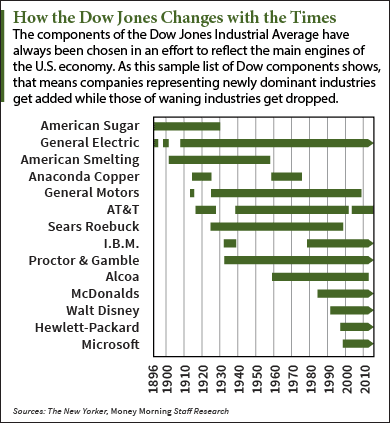The recent addition of Apple Inc. (Nasdaq: AAPL) to the roster of Dow Jones Industrial Average companies begs the question of which changes to the DJIA we're likely to see next.
Apple replaced long-time Dow Jones component AT&T, Inc. (NYSE: T) on March 19. Such changes to the DJIA companies reflect shifts in the U.S. economy.
 That's because one of the goals of the "Averages Committee" - the folks who determine the make-up of the 30-stock index - is to pick companies that represent top U.S. industries.
That's because one of the goals of the "Averages Committee" - the folks who determine the make-up of the 30-stock index - is to pick companies that represent top U.S. industries.
The task is ongoing, of course. As the U.S. economy has evolved, so has the list of Dow Jones Industrial Average companies.
Apple, as one of the most successful consumer tech companies in the world, had earned a spot in the DJIA. AT&T, once synonymous with telecommunications, doesn't have the clout it once did.
The shift comes less than two years after three new stocks became DJIA companies. Goldman Sachs (NYSE: GS), Visa Inc. (NYSE: V), and Nike Inc. (NYSE: NKE) replaced Alcoa Inc. (NYSE: AA), Bank of America Corp. (NYSE: BAC), and Hewlett-Packard Co. (NYSE: HPQ) in September of 2013.
It's clear the Averages Committee has a preference for dynamic, growing companies as much as it loses interest in those that lose even some of their luster.
Right now, several big and growing U.S. companies are prime candidates to join the DJIA when the committee makes its next move. And looking at the current list of Dow Jones Industrial Average companies, it's not hard to find those most likely to get the boot.
So how do you determine a DJIA candidate?
The Criteria for Dow Jones Industrial Average Companies
While Dow selection is subjective, the Averages Committee does use some general criteria to ensure only top blue-chip sticks make it in.
Eligible DJIA stocks must be part of the Standard & Poor's 500, with the exception of transportation and utilities stocks (as they each have their own Dow averages). Dow Jones stocks must also be incorporated and headquartered in the United States, with most of its revenue coming from the U.S.
In addition to contributing to a mix representative of the U.S. economy, the S&P Dow Jones Indices methodology lays out these guidelines: "A stock typically is added only if the company has an excellent reputation, demonstrates sustained growth, and is of interest to a large number of investors."
Another quirk of the Dow Jones is that changes are made as needed. So you can have changes come less than two years apart, as we've just seen. Or the index can stand pat for many years, as occurred between 1959 and 1976.
But with shifts in the U.S. economy coming ever more rapidly, changes to the DJIA are more likely sooner rather than later.
Three stocks in particular have the best shot to be next to join the Dow Jones...
Three Top Prospects to Become DJIA Companies
These three companies best illustrate where today's U.S. economy is going:
Add Facebook Inc., Remove IBM Corp.
Why Facebook belongs in the DJIA: While relatively young, Facebook Inc. (Nasdaq: FB) has proven itself as a key, cutting-edge tech company. Facebook is the biggest social media firm - a major sector of tech unrepresented in the Dow Jones at the moment. But more than that, Facebook has led the way on mobile advertising and is rapidly expanding its mobile platform. It's also pushing ahead into other up-and-coming areas of tech, particularly virtual reality.
Why IBM should be booted: While International Business Machines Corp. (NYSE: IBM) was once synonymous with tech, this rapidly changing sector has mostly passed Big Blue by. Struggling to compete, IBM was forced to sell off chunks of its business, such as its PC business. Now it's looking to cloud computing for salvation, but is unlikely to overtake new tech titans Amazon.com Inc. (Nasdaq: AMZN), Google Inc. (Nasdaq: GOOGL, GOOG), and Microsoft Corp. (Nasdaq: MSFT).
Add Amazon.com, Remove McDonald's Corp.
[epom key="ddec3ef33420ef7c9964a4695c349764" redirect="" sourceid="" imported="false"]
Why Amazon.com belongs in the DJIA: E-commerce has changed how Americans shop. And Amazon.com practically invented e-commerce. The company's tendency to reinvest most of its profits will pay off soon with features like same-day delivery. Plus, Amazon is the leader in cloud-based services (see IBM), another key area of tech.
Why McDonald's should be booted: The era of fast food has peaked. McDonald's Corp. (NYSE: MCD) struggles of late are proving it. Consumers are eating on the go more than ever, but more and more are opting for healthier choices like Panera Bread (Nasdaq: PNRA) or Subway. It's time for fast food to exit the Dow Jones.
Add First Solar Inc., Remove Chevron Corp.
Why First Solar belongs in the DJIA: Pushed by technological advances and such trends as electric cars, alternative energy in general and solar in particular will become a much bigger part of the energy equation over the next decade. And First Solar Inc. (Nasdaq: FSLR) is at the forefront of this dramatic shift in where and how we get energy. It might seem too soon to add a solar company to the DJIA, but the tipping point is not as far off as people think. [We told readers last week just how close it is - find out more here.]
Why Chevron should be booted: While oil will be with us for many years to come, fossil fuels will become less critical in the years ahead. Oil still deserves a place in the DJIA, and should have adequate representation via Exxon Mobil Corp. (NYSE: XOM).
Don't Overlook the Dow Rejects: Whenever we see changes to the DJIA stocks, some investors assume the dumped companies should be avoided. But a look at the record indicates just the opposite. In fact, in the years that follow, most of the Dow rejects actually outperform the companies that replaced them. Here's why it happens - and how you can use this phenomenon to profit...
Follow me on Twitter @DavidGZeiler.
About the Author
David Zeiler, Associate Editor for Money Morning at Money Map Press, has been a journalist for more than 35 years, including 18 spent at The Baltimore Sun. He has worked as a writer, editor, and page designer at different times in his career. He's interviewed a number of well-known personalities - ranging from punk rock icon Joey Ramone to Apple Inc. co-founder Steve Wozniak.
Over the course of his journalistic career, Dave has covered many diverse subjects. Since arriving at Money Morning in 2011, he has focused primarily on technology. He's an expert on both Apple and cryptocurrencies. He started writing about Apple for The Sun in the mid-1990s, and had an Apple blog on The Sun's web site from 2007-2009. Dave's been writing about Bitcoin since 2011 - long before most people had even heard of it. He even mined it for a short time.
Dave has a BA in English and Mass Communications from Loyola University Maryland.



